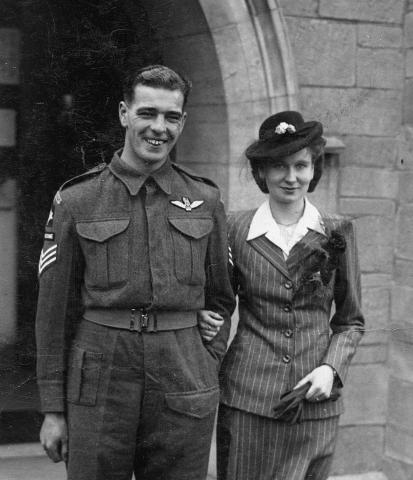George Nye, born in 1920, joined 137 Field Ambulance Royal Army Medical Corps, a Territorial Army unit based in Derby (giving the wrong age) in April 1936 . After 3 years, having attained the rank of Lance Corporal, George joined the Regular Army on a 12 year engagement in the Royal Army Service Corps (RASC) at Aldershot.
After the completion of recruit training and driving school, the outbreak of war in September 1939 saw the detachment posted to the British Expeditionary Force as part of 1 Corps Supply Company near to Lille, Northern France. On 31 May, George was evacuated at Dunkirk and by 11 June was back in Aldershot.
By the beginning of August the company had completed its re-organisation and was ordered to move to Northern Ireland with a new title of 6 Corps Supply Company RASC. In August 1942, George attended an air crew selection board in Belfast and was passed fit for pilot training in the Army Air Corps.
George commenced flight training and completed the course on 9 March 1943. After completing a refresher course and a posting to Glider Training School (GTS) at Shobdon, he was thrilled to receive his red beret after a very testing, but nevertheless enjoyable time.
After fourteen days leave following his marriage to Ivy, George rejoined A Squadron and was sent on another refresher course with the Glider Pilot Exercise Unit. After he had completed the course and a couple of exercises George joined the newly formed B Squadron.
He took part in Operation Tonga on 6 June 1944, where after light opposition and few casualties, success was achieved. Further operations were being planned, and cancelled, as the Allies advanced quickly through Europe. Soon Operation Market Garden was planned and it seemed that this might be the ‘real thing’.
On Sunday 17 September 1944, Operation Market Garden was launched. George, as part of the second lift, landed on Landing Zone (LZ) Z and after aiding 1st Airlanding Light Regiment Royal Artillery he returned on 28 September.
The next few months were spent in reorganising and training 800 RAF pilots to join the Glider Pilot Regiment. In support of this, George instructed at the Ivanhoe Range near to Dunstable.
On 24 March 1945 George took part in Operation Varsity. Having landed on their designated LZ, the glider was quickly unloaded and on 27 March the glider pilots withdrew from the concentration area. By 30 March 1945 George flew from Eindhoven to RAF Keevil, glad to be home but conscious of comrades who had failed to make the round trip. It had been a successful operation.
George was demobilised on 24 March 1946.
Compiled by Mike Peters and edited by Josephine Bailey
Read More




Latest Comments
There are currently no comments for this content.
Add Comment
In order to add comments you must be registered with ParaData.
If you are currently a ParaData member please login.
If you are not currently a ParaData member but wish to get involved please register.